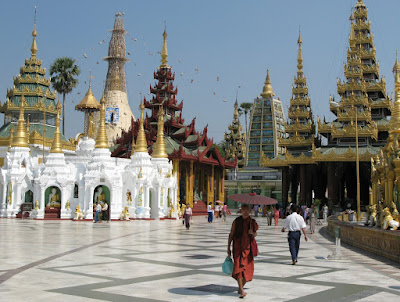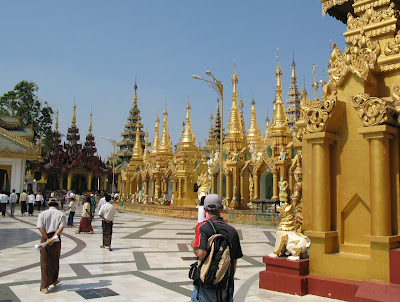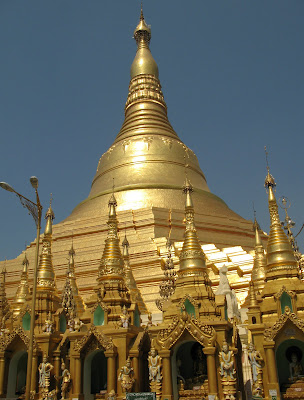.JPG) Resting in the heart of the Rangoon (Yangon), on Singuttara Hill, is the majestic Shwedagon Pagoda. It alone is worth a visit to the bustling city of Rangoon.
Resting in the heart of the Rangoon (Yangon), on Singuttara Hill, is the majestic Shwedagon Pagoda. It alone is worth a visit to the bustling city of Rangoon..JPG) A boy points the way to one of the four entrances to the Shwedagon Complex. No footwear, including socks, are allowed to be worn throughout the complex, which include the long covered walkways leading up to the temples and pagodas. These boys are glad to sell you plastic bags for your shoes. Do not leave shoes unattended at the entrances unless you want to walk barefooted back to your hotel.
A boy points the way to one of the four entrances to the Shwedagon Complex. No footwear, including socks, are allowed to be worn throughout the complex, which include the long covered walkways leading up to the temples and pagodas. These boys are glad to sell you plastic bags for your shoes. Do not leave shoes unattended at the entrances unless you want to walk barefooted back to your hotel..JPG) A pair of chinthe (mythical lions) stand guard at each of the four entrances leading to the complex.
A pair of chinthe (mythical lions) stand guard at each of the four entrances leading to the complex..JPG)
.JPG) The Shwedagon Pagoda, according to legend, is believed to be around 2,500 years old. However, archaeologists estimate it was first built by the Mon people sometime between the 6th and 10th centuries, during the Bagan period. The pagoda emerges from legend into history in 1485, which is the date of an incription near the top of the eastern stairway that tells the story of Shwedagon in three languages (Pali, Mon, and Burmese).
The Shwedagon Pagoda, according to legend, is believed to be around 2,500 years old. However, archaeologists estimate it was first built by the Mon people sometime between the 6th and 10th centuries, during the Bagan period. The pagoda emerges from legend into history in 1485, which is the date of an incription near the top of the eastern stairway that tells the story of Shwedagon in three languages (Pali, Mon, and Burmese)..JPG)
.JPG)
.JPG)
.JPG)
.JPG)
.JPG)
.JPG)
.JPG)
.JPG)
.JPG)
.JPG) The massive pagoda stands 321.5 feet high and is a dominating structure which can be seen from many parts of the city. Enshrined in the pagoda are relics of the last Buddha (Siddhartha Guatama) as well as the previous three Buddhas. It is the most sacred Buddhist pagoda for the Burmese people.
The massive pagoda stands 321.5 feet high and is a dominating structure which can be seen from many parts of the city. Enshrined in the pagoda are relics of the last Buddha (Siddhartha Guatama) as well as the previous three Buddhas. It is the most sacred Buddhist pagoda for the Burmese people.The gold on the surface of the stupa is made of genuine gold plates (9272 one-square foot each)and is attached by traditional rivets. The tradition of giving gold began in the 15th century with the Mon Queen, Shin Sawbu, who was said to have given her weight in gold for the temple. The Burmese people today still carry out the tradition, although not with their weight in gold obviously.
.JPG) The crown or umbrella is tipped with 5,448 diamonds and 2,317 rubies. The diamond bud at the very top is tipped with a 76 carat (15 gram) diamond.
The crown or umbrella is tipped with 5,448 diamonds and 2,317 rubies. The diamond bud at the very top is tipped with a 76 carat (15 gram) diamond. .JPG)
.JPG) If you visit the Shwedagon complex in the late afternoon, or early evening, the place will seem a bit deserted. When the lights come on, an eerie feeling comes over the complex. Although it may seem like an ideal time to visit, it's during the bustling worshipping hours during the day that make it the most interesting time for a visit.
If you visit the Shwedagon complex in the late afternoon, or early evening, the place will seem a bit deserted. When the lights come on, an eerie feeling comes over the complex. Although it may seem like an ideal time to visit, it's during the bustling worshipping hours during the day that make it the most interesting time for a visit. The Pagoda Complex is open daily for worshippers and visitors from 4 am until 10 pm.
Tourists pay $5 USD to visit.
.jpg)
.JPG)
.JPG)
.JPG)
.JPG)
.JPG)
.JPG)
.JPG)
.JPG)
.JPG)
.JPG)
.JPG)
No comments:
Post a Comment